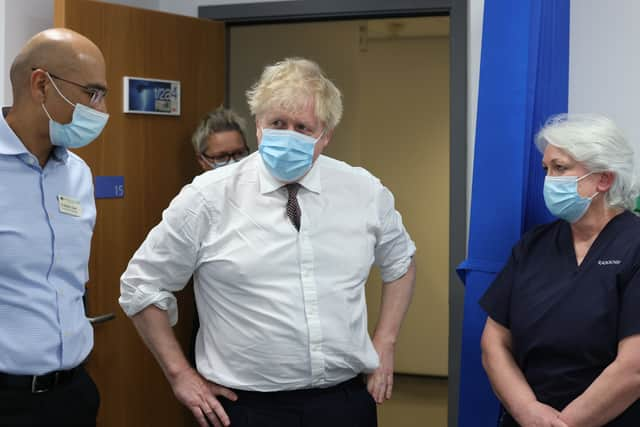40 hospitals pledge: government will not fulfil promise to build 40 new hospitals by 2030, report says
and live on Freeview channel 276
A National Audit Office (NAO) report claims that the government will not fulfil its 2020 commitment to build 40 new hospitals by the end of the decade.
The pledge was made in part due to the £10.2 billion maintenance backlog facing British hospitals, more than 43% of which were built before 1985. Seven hospitals are structurally unsound and in need of urgent and complete replacement.
Advertisement
Hide AdAdvertisement
Hide AdIn response to the crisis the Department of Health and Social Care (DHSC) established a Health Infrastructure Plan (HIP) in 2019 to improve the efficiency, quality and standardisation in hospital construction.
The HIP listed 27 new hospital schemes to be completed by 2030, and in 2020 the government expanded the plan - pledging to build 40 new hospitals by that time.
However, a report released today by the National Audit Office (NAO), states that this pledge will not be met by the deadline.


What was the government’s 40 new hospitals pledge?
The government under Prime Minister Boris Johnson in 2020 made a promise to build 40 new hospitals by 2030. The New Hospital Plan (NHP) was set up to carry out this mission, however, the definition of a ‘new’ hospital was fairly broad.
Advertisement
Hide AdAdvertisement
Hide AdThe DHSC said that a new hospital could be defined as - a complete new build, rebuilds of existing hospitals, major new buildings at existing sites, and major refurbishments of existing buildings.
The NAO report found that of the 32 new hospitals detailed in the 2020 plan, 11 were entirely new hospitals, whilst 20 were another type of build that met the DHSC’s definition of a new hospital, and one scheme did not meet the government’s definition of a new hospital. DHSC has decided to split one scheme which was for two hospitals into two schemes to account for this.
Seven schemes and plans for one new hospital had been agreed before the NHP was developed, leaving 48 schemes to be completed in total. New hospital schemes were originally split into four cohorts, but the scheme was reset in May 2023, with new projects added, creating a fifth cohort, and other schemes delayed to the 2030s.
It was estimated that it would cost between £20 billion - £30 billion to complete all the new building schemes, but so far only £3.7 billion had been provided up to the year 2024-25.
Advertisement
Hide AdAdvertisement
Hide Ad

Why won’t the government build 40 new hospitals by 2030?
The NAO report suggests that the government will not be able to meet its building target because of delays in the construction process. Gareth Davies, head of the NAO, said that delivery has been ‘slower than expected’.
As the majority of funding required for the project has not yet been provided, it is likely that construction will have to take place across several sites at once. This will require more builders and material to be available at the same time and is expected to drive up the price.
The NHP worked on the assumption that the building project would be carried out in five phases over the decade,
But, as of last month, three of the eight projects outlined in cohort one had been started, where five were expected, and the forecast costs of the cohort one and two schemes has risen by 41%.
Advertisement
Hide AdAdvertisement
Hide AdThe eight schemes that existed before the NHP, 24 hospitals within the NHP, three new mental health hospitals managed outside the NHP, and five hospitals that will replace existing ones that are not structurally sound, are expected to be built by 2030.
Therefore, of the 32 new hospitals that were set out in the 2020 plan, 24 are expected to be built by the 2030 deadline.
What have politicians said about the NAO report?
Meg Hillier, Labour MP and chair of the Public Accounts Committee, said: “The Department of Health and Social Care has been trying to move the goalposts so it can claim it has met its target. Patients and clinicians are going to have to wait much longer than they expected before their new hospitals are completed.”
Wes Streeting MP, Labour’s Shadow Health Secretary, said: “This shocking report could not be more damning of the failing new hospitals programme. The so-called 40 new hospitals are over-budget, behind schedule, and may be too small. Many are not ‘new’, others are not ‘hospitals’, and there aren’t 40 of them. In fact, just one hospital is on track to be built by the next election.
Advertisement
Hide AdAdvertisement
Hide Ad"The Conservatives have over promised, under-delivered, and they’ve been found out. Meanwhile patients are being treated in outdated, crumbling hospitals. Labour will make our NHS fit for the future."
Despite the report’s findings, a DHSC spokesperson said: “The NAO’s report acknowledges that despite changes to the original programme, 40 new hospitals are still expected to be delivered by 2030 and praises the programme’s innovative plans to standardise hospital construction, deliver efficiencies and improve quality.
“We remain firmly committed to delivering these hospitals, which are now expected to be backed by over £20 billion of investment, helping to cut waiting lists so people can get the treatment they need quicker. Three new hospitals have already opened and more will open this year so patients and staff can benefit from major new hospital buildings, equipped with the latest technology.”
Comment Guidelines
National World encourages reader discussion on our stories. User feedback, insights and back-and-forth exchanges add a rich layer of context to reporting. Please review our Community Guidelines before commenting.
